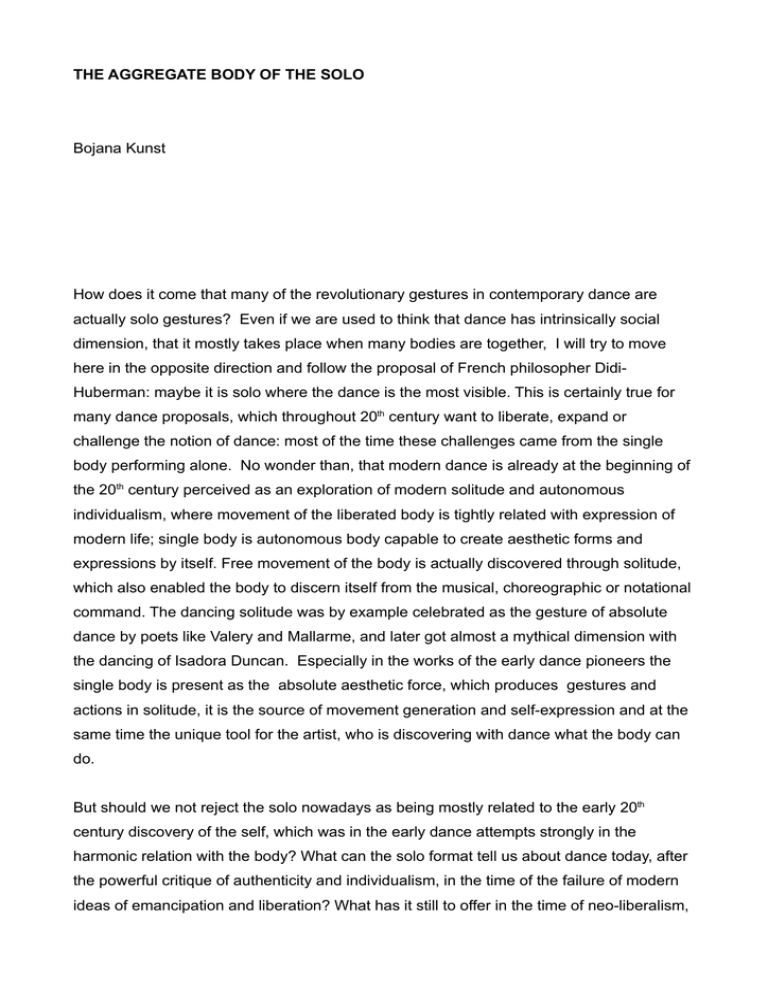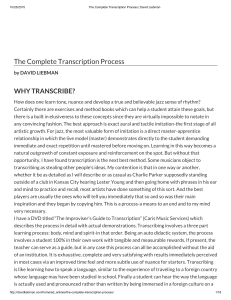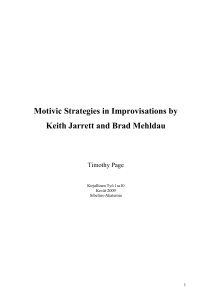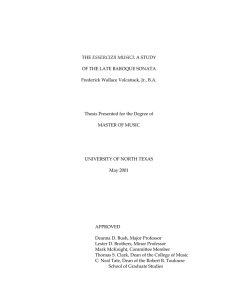AGGREGATE BODY OF THE SOLO Bojana Kunst
Anuncio

THE AGGREGATE BODY OF THE SOLO Bojana Kunst How does it come that many of the revolutionary gestures in contemporary dance are actually solo gestures? Even if we are used to think that dance has intrinsically social dimension, that it mostly takes place when many bodies are together, I will try to move here in the opposite direction and follow the proposal of French philosopher DidiHuberman: maybe it is solo where the dance is the most visible. This is certainly true for many dance proposals, which throughout 20th century want to liberate, expand or challenge the notion of dance: most of the time these challenges came from the single body performing alone. No wonder than, that modern dance is already at the beginning of the 20th century perceived as an exploration of modern solitude and autonomous individualism, where movement of the liberated body is tightly related with expression of modern life; single body is autonomous body capable to create aesthetic forms and expressions by itself. Free movement of the body is actually discovered through solitude, which also enabled the body to discern itself from the musical, choreographic or notational command. The dancing solitude was by example celebrated as the gesture of absolute dance by poets like Valery and Mallarme, and later got almost a mythical dimension with the dancing of Isadora Duncan. Especially in the works of the early dance pioneers the single body is present as the absolute aesthetic force, which produces gestures and actions in solitude, it is the source of movement generation and self-expression and at the same time the unique tool for the artist, who is discovering with dance what the body can do. But should we not reject the solo nowadays as being mostly related to the early 20th century discovery of the self, which was in the early dance attempts strongly in the harmonic relation with the body? What can the solo format tell us about dance today, after the powerful critique of authenticity and individualism, in the time of the failure of modern ideas of emancipation and liberation? What has it still to offer in the time of neo-liberalism, which even radicalizes singular gestures into the continuous process of self-invention, free choice and self-transformation? What to say then about singular dancing body today? It is true, that at the beginnings of modern dance the solo gesture was mostly related to the exposure of authentic and expressive body, which unfolds itself through solitude, however the solo gesture comes back again as a very powerful dispositif in the neoavantguarde experiments, which don´t have much to do with the essentialist understanding of solitude. This time the gesture of the singular body is at work in performance art and post-modern dance , challenging the expressions and limits of the artistic acts and shifting the borders between different media of art (especially among dance, visual arts and music). It is mostly the singular body of the artist which crosses different media and questioning the way how art is made (how the painting is painted, the music is composed, the dance is danced). When writing about solo actions of the 60thies, performance theoretician Rebecca Schneider observes, how solo is tightly related to the unbecoming of specific genre or media distinction. “As part of rise of the solo we find a painter becoming a dancer (Pollock); a painter becoming an actor painting or marking her body as stage (Carolee Schneemann), an architect building a structure becoming an auteur dancing a structure (Robert Wilson); a dancer becoming an opera maker (Meredith Monk), a conceptual artist becoming a musician (Yoko Ono); a musician becoming a painter (Le Monte Young). Each of this becoming solos underscores an unbecoming – a kind of double move (...)” (41). From this perspective, solo in the neo-avantguarde experiments is not at all related to the unfolding of the body and his inner movement, but rather to the continuous re-positioning, crossing and retelling: solo is the main format for the artistic act, working most of the time against its singular status. The solitude of the body is not arising from the unfolding of movement from the body, but from the act of doing, where body is explored as the material and tool, a non-intentional matter, a movement composite. This is then the solitude of the material, which unfolds itself in time and space. And again, the gesture of solo is repeated in the dance performance in the nineties (like Xavier Le Roy, Jerome Bel, Juan Dominguez, La Ribot etc.), which not only wished to expand the field of dance and challenge the too obvious relation between dance and continuous movement. Beside that, also the notion of the single artistic personality is scrutinized and the immediate link between the body and its artist ( the body and its author) is critically exposed. The relation between singularity of the artist and singularity of the body haunts contemporary dance throughout its history and is described by Isabelle Launay as a “history of possession.” It seems namely as it if the dance belongs to the body of the dancer, and the dance work is many times experienced as the incarnation of either authorial (genius) self or quasi-magical nature; “therefore citation in dance was formally forbidden”. The history of possession springs of course from the inaugurational gesture of the solo as the act of the unfolding of the inner-self, which was constitutive for the solo format at the beginning of the 20th century. However it is also strongly related to the artistic act in the sixties, where possession is not so much related to the self, but to the conceptual proposal of an artist. But it is a solo again, through which the critique of the singularity is made, again re-questioning is exposed with the solitude of the body. In many recent performances the solitude appears as the never fulfilled process of embodiment, a solitude of an experiment, which is always slightly idiotic and clumsy, or exposed as an endless enumeration of fragments, a gesture which stays in-between, it is the powerful gesture of the body which is not only moving, but it is being moved by different forces. We can therefore conclude that solo is a paradoxical format, which is actually not the most appropriate format for the expression of the one, but exactly the opposite: the solo is always more than one. The solo is such an intriguing format because it can continuously undermine its own foundations and disclose how ´doing solo´ has actually not so much to do with the singularity of the body, glued together with the singularity of an artistic act. The solitude of the body is actually undermining the balance between the body and single artistic act, between the doing and representation of doing, between the movement and the self, there is always less and more at the same time at work in the body, the lack of movement goes hand in hand with its abundance. Solo then actually appears as the place of critique of the self, the stubborn attack on the ordering source of movement, resisting any intentional understanding of the body as the self-rotating wheel. In the solitude of the solo the body is challenged as the sole kinetic source of movement and kinaesthetic virtuosity is disclosed not as something which would be intentional. If this would be the case than the bodies would be only containers of movement, they would have a kinaesthetic core as a fountain in the park, a single source of transformation. But bodies are rather landscapes, composites of moving forces, made from other composites, where it is impossible to discern between the one and the many, it is impossible to draw a border between the body and the space, between the body and its expansion in time. The dance becomes visible in the solo, not because of the reduction to the single body, but because the single body is a plural in itself, and this is also the very reason why dance can mediate into an entirely different form. Such an understanding of the solo is particularly pivotal nowadays, when we are confronted with numerous solo explorations in performance, but at the same time also with the radical cultural individualization of the subject which goes together with the neo-liberal understanding of individual freedom. What can the reflection about solo bring in the time, when social isolation becomes more and more a general outcome of the contemporary modes of economic production, and when it seems we would rather need more of kinaesthetic knowledge of how to be together than of how to be alone? Many dance explorations of today are going back to the choreographic aspect of dance, and rethinking the ways how the bodies move together, the forces and lines of social and aesthetic composition. However the solo can still persist as a highly subversive format, especially because it can undermine the simple understanding of subjectivity as the source of all movement and disclose its unintentional, material body, which exactly through solitude discloses that it could never be only the body of one. The solo is not a format of practicing isolation, but embodiment of solitude, which, as philosopher Artemy Magun, writes, is not to be understood as unity, but a longing of the one to go beyond itself. “And indeed, the moment when humans perceive a things´s loneliness, both are not lonely anymore. Or, maybe, it is because they meet, qua solitudes, they are truly solitary: together.” (23). In this sense the body of solo is already always an aggregate, a plural field, in itself already a choreographic mess, which always resist to be reduced to the number of the one. Only such an aggregate can fight back the social isolation, which is denying the plurality in our bodies and deploying the subjects with the continuous social and technological apparatuses to become many, when at the same time it is becoming more and more difficult to meet the other. The body of solo can be then seen as a powerful format to resist the fetishistic approach to individualization and need for continuous transformation. The subject moves because it can be moved, it is a gesture of response, especially in solitude. Thank you Idoa and Ixiar, for the generosity of solitude in Azala Space for Creation, where this text was written. Bojana Kunst is a philosopher, dramaturg and performance theoretician. She is a professor at the Institute for Applied Theater Studies in Justus Liebig University Giessen, where she is leading an international master program Choreography and Performance. Her new book Artist at Work will be published by Zero Books in August 2015. Literature: Georges Didi-Huberman: Le Danseur des Solitudes, Les Éditions de Minuit, 2006. Isabelle Launay: Citational Poetics in Dance: . . . of a faun (fragments) by the Albrecht Knust Quartet, before and after 2000, 2012, Congress on Research On Dance, 2012. Artemy Magun: Unity and Solitude, Politics of the One, Concepts of the One and Many in Contemporary Thought, Bloomsburry, 2012. Rebecca Schneider: Solo, Solo, Solo, After Criticism: New Responses to Art and Performance, edited by Gavin Butt. Blackwell, 2001.


